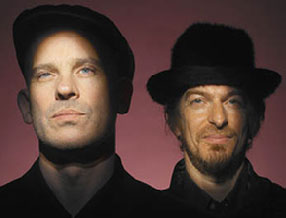Remixing Reich: Steve Reich, DJ Spooky, Coldcut, Konono No.1 at the Barbican 7th October 2006
 I jumped for joy when I realised that Steve Reich was coming to town to celebrate his 70th birthday. I am a long-time fan. He changed my life. As a hard working art student, messing and scratching with audio and video tape, as soon as I heard what he was doing with sound and music, he entered my personal Pantheon reserved for spiritual leaders, gurus, shamans, and good cooks. He is of those blessed with the understanding that music is an energy that runs from the beginning of time to the end of time, and that musicians are lucky enough to get to play it.
I jumped for joy when I realised that Steve Reich was coming to town to celebrate his 70th birthday. I am a long-time fan. He changed my life. As a hard working art student, messing and scratching with audio and video tape, as soon as I heard what he was doing with sound and music, he entered my personal Pantheon reserved for spiritual leaders, gurus, shamans, and good cooks. He is of those blessed with the understanding that music is an energy that runs from the beginning of time to the end of time, and that musicians are lucky enough to get to play it.Reich's first great period of minimalist compositions consist mainly of repeated tuned percussive patterns, with rising and falling chordal waves; the rhythms are constructed by addition and subtraction, they evolve and overlap, patterns catching one another up and overtaking, blending and phasing; this is what Reich is mainly known for. But, his subtle, jazz-inflected chords build a momentous emotional feeling over the cascading, African-shaded, travelling rhythms, and this harmonic sensitivity is every bit as important in his music. Drumming is Reich's most utterly hypnotic work, a seminal piece 90 minutes long, which in the days before audio CDs, let alone DVDs, I possessed in the form of four disks - eight sides! - of LP vinyl.
Some people, lost without a single clear progressive line to follow, can only witness a busy curtain of sound, and their concentration drifts off as the music weaves betweens tapestry layers. Others report heightened states as their consciousness peels back the veil between music and cosmic vibration. But this music is neither pretentious - in person, Reich is the plain-speaking New York antithesis of this - nor difficult to "get", and having much in common with more popular forms of music, has been widely accepted where other contemporary classical music has not.
Reich's modern compositions cannot these days be labelled 'minimalist' by any stretch of the imagination, and they have done much to assert Reich's legacy among classical academicians. But, the old compositions have sold steadily since the 1970s - at one point, it was de rigeur to possess a copy of Reich's Music for 18 Musicians, and something by Philip Glass - and remain his most popular. I personally recommend Variations for Wind, Strings and Keyboards (see below) if you wish to hear what all the fuss is about.
 For me, though, as with his millions of fans, his music is vigorous and inventive, and full of the kind of detail you find at the Alhambra - arabesques, the joyful, endless permutation of essential pattern, the structural keys of life itself. In his later compositions, from The Desert Music onwards, the of which premiere I attended at the Royal Albert Hall some years ago, Reich moved into a less austere, more traditional symphonic mode, and began to utilise 'spiritual' texts. The following evening's premiere Daniel Variations was typical of Reich's modern work, combining quotations from the Biblical Daniel with the words of the murdered American journalist Daniel Pearl.
For me, though, as with his millions of fans, his music is vigorous and inventive, and full of the kind of detail you find at the Alhambra - arabesques, the joyful, endless permutation of essential pattern, the structural keys of life itself. In his later compositions, from The Desert Music onwards, the of which premiere I attended at the Royal Albert Hall some years ago, Reich moved into a less austere, more traditional symphonic mode, and began to utilise 'spiritual' texts. The following evening's premiere Daniel Variations was typical of Reich's modern work, combining quotations from the Biblical Daniel with the words of the murdered American journalist Daniel Pearl. The concentration necessary to play this music is complete. Reich led his own ensemble, all white shirts and white-haired, now in their 60s and 70s, all filled with a consummate vitality and composure. It was was enthralling watching them calmly take over, one from another, after an intense 15 minute section hitting marimba or glockenspeil; I never saw a beat missed during the changes. The stage scene was also beautiful to watch, great, grand mallet instruments laid out on stage, back to back, rows of bongos. Drumming also contains four pianos, and the richness of four Steinway Grands powering the centre of this astonishing collection of instruments still fills me with awe several days later.
As the roaring ovation for Reich and his ensemble finished, I thought to myself, this could be the last time I see the original crew perform this work. My day was made, my heart satisfied, and we still had the second half to come.
DJ Spooky 'That Subliminal Kid' kicked off the second half with a gentle self-deprecating apology for being American at this time of gross national aberrance. He's one of several US artists I've seen recently who have stood before a tolerant UK audience and said, look, the Bush adminstration - we hate it too.

He played a wonderful combination of abstract turntablism with the Kronos Quartet, reprising Reich's City Life which worked surprisingly well in the concert hall setting.
Next up, and only after some agonising pre-gig computer technical hitch, Coldcut, remixing 18 Musicians.
 This was much more genuinely experimental than the DJ Spooky set but somehow just avoided falling flat on it's arse, but you got the impression this was more by luck than judgement. I could hear Matt Black (in his reggae hat) "playing" his Spectrasonics Stylus generative software, which I found mildly disconcerting as I know how easy this is to do, and so I questioned the amount of performance actually going on. But the sound was good, the visuals were excellent (of course) and my soft spot for these magpies of subculture remained undiminished, even by the ragged ending which left the audience unsure of whether to clap.
This was much more genuinely experimental than the DJ Spooky set but somehow just avoided falling flat on it's arse, but you got the impression this was more by luck than judgement. I could hear Matt Black (in his reggae hat) "playing" his Spectrasonics Stylus generative software, which I found mildly disconcerting as I know how easy this is to do, and so I questioned the amount of performance actually going on. But the sound was good, the visuals were excellent (of course) and my soft spot for these magpies of subculture remained undiminished, even by the ragged ending which left the audience unsure of whether to clap.Finally, Konono No.1 from the Angola-Congolese border region of Bazombo who with typical African resourcefulness use repurposed metal kitchenware and 1950s loudspeakers to create the most driving and uplifting sound you can imagine. The musical relationship between this group and Reich was closer than Coldcut's or Spooky's, in the development of the patterns of beats, the minimal arrangements, the way vocals join and repeat choruses, the driving, organic vitality, thumb pianos played through amplifiers providing an exciting hybrid which every outdoor festival in Europe should book immediately. It took me in the end back to Drumming and Reich's African studies, and also back to my college days when I first heard the bright colours, unstoppable rhythms and phenomenal power of African music via Fela Kuti and Sunny Ade.
I've seen several of these kinds of retrospective concerts, which attempt to revisit a 'great' composer in the light of his interpreters and influences, and this Barbican series is without a doubt the most successful, because of the extent and the inventiveness shown in assembling such an astonishingly rich and full program. I've only covered one evening - I haven't been able to write about the next evening except in passing - and I didn't attend any of the supplementary gigs about town, with the exception of the excellent Bang On A Can in the foyer. Yet still, a week later, I am replete with experience, revitalised, and thrilled to be alive at the same time as this remarkable man and his music.
Steve Reich website
Steve Reich wiki
Steve Reich London Barbican review









1 Comments:
Your passion for music is appreciated.
Post a Comment
<< Home